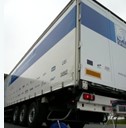|
 |
| Applications |
 |
DC-BUS in Renewal Energy
Powerline Battery Management System

Modern Renewable energy generators such as Solar panel using Photo voltaic panels or Battery pack such as Lithium-Ion in electrical vehicle, requires strict operation within specified temperature and voltage range of each of the cells constructing an energy string. A cell that operates outside its specified conditions will not bring its optimal energy capability, can permanently be damaged and may be hazardous. Therefore, a NanoGrid network that monitors each of its constructing cells is essential.
The DC-BUS SIG60 devices provide simple connectivity between cells and the management system, generating a NanoGrid without extra wiring. In a Battery Management System (BMS) each battery pack provides information about its constructing cells; the cells voltage, temperature and usage history. This information determines the optimum charging profile and to control its usage. Sleep mechanism keep power down when system is not used. The intelligent charging and discharging extend the life of the re chargeable batteries by 50%. In Solar panels, operating each panel in its optimized operation point will increase significantly the output power of the entire PV string.
|
 |
DC-BUS in Automotive
Powerline for Front and Back Lights
 Controlling vehicle's front and back lights from a master Steering-wheel (or vehicle's ECU) over Powerline Communication (PLC)using SIG60 and SIG61 DC-BUS devices saving harness size, weight and cost. Controlling vehicle's front and back lights from a master Steering-wheel (or vehicle's ECU) over Powerline Communication (PLC)using SIG60 and SIG61 DC-BUS devices saving harness size, weight and cost.
A SIG60 Master module mounted in Steering-wheel lights and wiper switches generate a message whenever any switch change its position. The message is conducted over the powerline by modulated High frequency carrier, to each of the front and back light bulbs/LEDs modules. The communication is bidirectional, allowing to sense each of the lamps current to detect faulty bulbs and send this information back to the master. Each module has a SIG61 device and MOSFET power drivers. To distinguish between the multiple Front and Backlight units, each of them has unique address.
Sleep mechanism keep power down when system is not used. |
 |
DC-BUS for Consumers
Smoke Detectors Network
 The DC-BUS powerline communication provides a common platform for inter functionality between smoke detectors, allowing seam less interaction between sensors and actuators (alarm, sprinkle)connected to each of the blocks using a common battery line also for multiplex communication. This platform allows all kind of security applications based on the DC-BUS powerline communication between the building blocks; each has its own identity and functionality. The unique DC-BUS technology and devices for communication over the noisy battery powerline allows simple communication between the blocks without any additional wires. High frequency modulation and error correction over the battery powerline provides seam less interaction between the sensors, actuators and its Master control module. The information regarding the connected blocks and its sensors and actuators determines the profile of operation of the combined smoke detection network. The DC-BUS powerline communication provides a common platform for inter functionality between smoke detectors, allowing seam less interaction between sensors and actuators (alarm, sprinkle)connected to each of the blocks using a common battery line also for multiplex communication. This platform allows all kind of security applications based on the DC-BUS powerline communication between the building blocks; each has its own identity and functionality. The unique DC-BUS technology and devices for communication over the noisy battery powerline allows simple communication between the blocks without any additional wires. High frequency modulation and error correction over the battery powerline provides seam less interaction between the sensors, actuators and its Master control module. The information regarding the connected blocks and its sensors and actuators determines the profile of operation of the combined smoke detection network.
|
| |
 |
|
|
|
|








